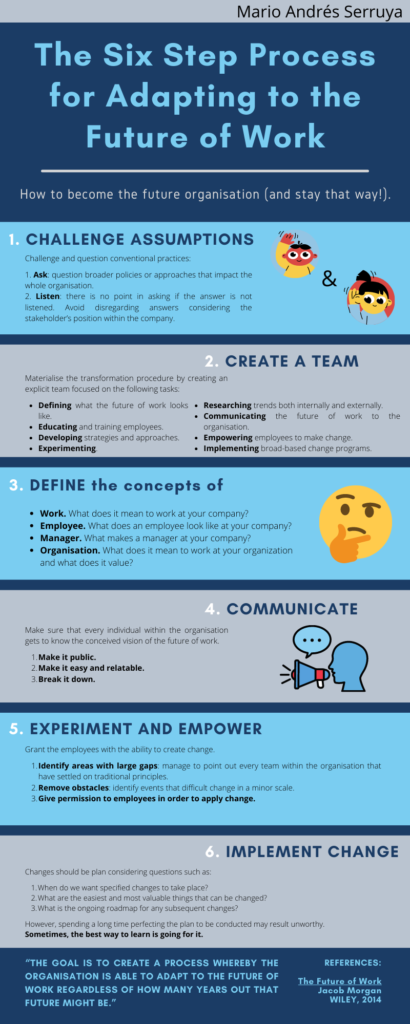The Six Step Process for Adapting to the Future of Work
Adapting to the future of work has turned into a challenge for companies around the world. Integrating the concept of future employee and future manager requires change. However, the final objective involves the creation of a process that will make companies able to adapt to the future of work regardless of the number of years remaining for its arrival.
Consequently, the following sections introduce the number of steps conforming a transformation procedure in order to adapt to the future work becoming the future organization and staying that way.
1. Challenge Assumptions
The first step constituting the adaptation process involves identifying what must be changed. In order to successfully conduct the concerned step, conventional practices must be challenged and questioned as well as how things are done within the organization.
Therefore, trying to challenge assumptions, questions must be asked. Conventional practices cannot be challenged if questions are not asked. So, figure out which are the questions that shall be asked. This procedure can be conducted through in-person discussions, meetings, one-on-ones, surveys, or any other way. Most employees will relate to broader policies or approaches that have a broader and overarching impact on the organizations rather than focusing on specific tactical questions. It is to be mentioned that the more people can see the challenges, the better.
Once questions have been identified, do not forget about listening. Pay specific attention to how things are justified or explained. Moreover, answers must not be disregarded just be the participants rank within the organization as answers may come from employees, managers and stakeholders.
2. Create a team
The importance and difficulty of the adaptation process must not be underrated. Therefore, multiple companies such as Whirlpool and Xerox have explicit teams dedicated to the understanding of the ever changing world and how these variations may affect the organization. These teams do not limit their task to research, but these come up with new programs aiming to ease the adaptation procedure through training and education. As a whole, these teams will be responsible for:
- Defining what the future of work looks like.
- Educating and training employees.
- Researching trends both internally and externally.
- Developing strategies and approaches.
- Experimenting.
- Communicating the future of work to the organization.
- Empowering employees to make change.
- Implementing broad-based change programs.
3. Define
Once the environment for the adaptation process development has been settled down, certain initial concepts must be specified. Organizations may have different viewpoints about the future of work. Defining initial concepts conforms a premature step that must be conducted. These concepts will condition each company’s vision of the future of work. And these concepts are:
- Work. What does it mean to work at your company?
- Employee. What does an employee look like at your company?
- Manager. What makes a manager at your company?
- Organization. What does it mean to work at your organization and what does it value?
4. Communicate
Conceiving a new vision about the future of work and different strategies on how to adapt to it does not make sense if nobody else but the entitled team within the organization knows about it. Successful companies follow certain guidelines to help make sure their vision for the future of work gets seen and heard, loud and clear. Three could be differentiated:
- Make it public. Let the world know what kind of organization you want to become and what the future of work looks like to you.
- Make it easy and relatable. Simplify the idea that the company is chasing down in order to make it clear and understandable.
- Break it down. It is required to specify how the vision of the future of work is going to be integrated into the company so that employees get a sense of what changes to expect and why those changes are happening.
5. Experiment and Empower
Grant the employees with the ability to create change.
- Identify areas with large gaps: manage to point out every team within the organization that have settled on traditional principles.
- Remove obstacles: identify events that difficult change on a minor scale.
- Give permission to employees in order to apply change.
6. Implement Change
Changes should be plan considering questions such as:
- When do we want specified changes to take place?
- What are the easiest and most valuable things that can be changed?
- What is the ongoing roadmap for any subsequent changes?
However, spending a long time perfecting the plan to be conducted may result unworthy. Sometimes, the best way to learn is going for it.
References:
Chapter 11, The Future of Work. Jacob Morgan – WILEY, 2014

